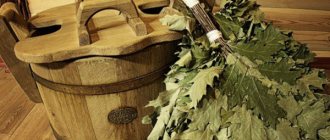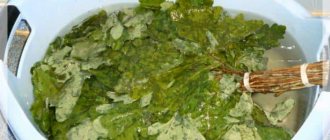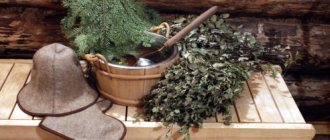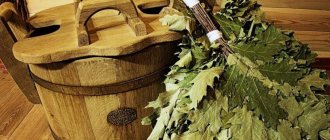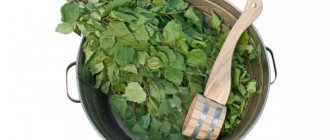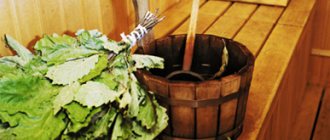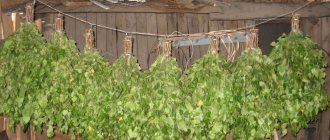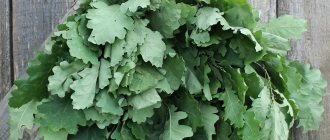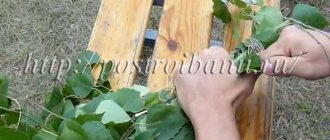A good broom is the key to a great bath. But what exactly are the parameters that shape these qualities? If the choice of material for harvesting is more or less clear, then questions arise regarding the timing when it is best to prepare brooms.
Experts say that a nettle broom collected in May and a nettle broom collected in July differ not only in their characteristics, but also in their properties.
Therefore, let's figure out when it is best to collect which drying mixtures and how, knowing these times, to create truly healing brooms that can remove waste and toxins from the body.
5/5 — (2 votes)
General tips and tricks
Everyone understands that the country’s climatic zones are diverse, so some knit brooms already in May, when others at that time had not even seen buds on the trees.
Here are some tips from experts on how to understand that the time has come to prepare brooms:
- Break off a small twig from the tree and try to pull the leaf. It should come off along the edge of the leaf blade, but at the same time “sit” tightly on the branch. If the leaf comes off at the point where it is attached to the branch, it is too early to knit brooms.
- Pay attention to the color of the leaf. It should be deep green. The foliage itself should be elastic and juicy. To do this, you can tear off a couple of sheets and grind it in your fist. A sign of good raw material is the release of a large amount of juice and the darkening of the leaf when it softens.
- Consider the growing season. There is no need to prepare brooms when the tree “hears” autumn and lets you know about it by the appearance of yellowish spots on the leaves or their edges. Our task is to collect a broom from branches that are filled with nutrients at the peak of the growing season. This period is different for each region. In some parts of the country, the leaves dry out and fall off already in August, so harvesting is best done in late May - early June.
Focus on your own feelings. Preparing brooms is a kind of magic that helps improve health in the winter season.
Advice! Don't forget that you shouldn't cut branches after it rains. They will dry worse, and the quality when steaming is inferior to those prepared in dry, warm weather.
Fir
Good fir brooms are obtained if they are cut in early spring - mid-summer. But fir brooms can be harvested at any time of the year, although they do not turn out as fragrant and fragrant. In general, they are poorly stored. They should not be dried out completely; the needles will simply fall off.
Tie the broom together with a tight fan, thicker branches inward, thin branches outward. The handle is cleared of needles. A fir broom fills the entire steam room with aroma and releases a lot of essential oils, so use gloves. You only need to steam a fir broom for a few minutes, after which it begins to lose its properties.
In the morning or evening?
As for the time period, expert opinions differ. If we turn to a botany textbook, we will understand that the active movement of nutrients through a tree occurs in the early morning after sunrise. Accordingly, if you cut a branch between 7 and 10 am, the foliage will have maximum benefit, which will be preserved and open when steamed.
Now let’s look at the opinions of two parmasters who “ate the dog” in their business.
Bulat Siraziev , a famous bath attendant in Tatarstan, claims that it is best to prepare brooms after 4 pm, when the movement of nutrients in the tree is still active, and all the excess moisture in the leaf has already evaporated under the influence of sunlight. Such a broom will dry faster and will be stored well for many years, and when steamed it will not shed leaves or give off an unpleasant musty smell.
Daniil Petrovsky , who is engaged in bathing and at the same time maintains his blog on YouTube, recommends making the cut in the morning, when the dew has disappeared, considering 9-11 o’clock the best option. In his opinion, this way a maximum of nutrients remain in the broom, which in the bathhouse will “create the magic of healing,” allowing a person to get rid of worries, worries, fatigue, problems with the musculoskeletal system and the heart muscle.
Both methods have their advantages and in practice it does not matter at all whether the branch is cut at 11 am or at 12. The main thing in this matter is to wait until the dew dries and the leaf warms up.
Birch broom
Experienced bath attendants will say that the procurement of birch brooms should be carried out no earlier than the beginning of August and here’s why:
- The leaf grows stronger on the branch, so it will not fall off during drying and steaming.
- Small branches are covered with bark, accumulating essential oils, which, at elevated temperatures, open up and thin out the incredible aroma.
- The leaf plate becomes more rigid and will not turn into mush when steamed.
Our ancestors believed that the best time for preparing brooms was the Trinity holiday, as well as this entire week on which it falls.
It is during this period that plants accumulate the maximum amount of useful substances, but in the case of birch this does not always work. Let's look at several ways to harvest birch brooms at different times and the benefits that each of them will have.
Harvesting a broom in early June
From June 1 to June 15, birch trees are most often cut into brooms, since it is at this time that the foliage is succulent, the branches are already strong, but not coarse, and enough nutrients and oily substances have accumulated in the bark. Select a low tree, cutting off the side branches using sharp pruning shears.
Expert opinion
Lovkachev Boris Petrovich
Bath master who knows everything about steaming
Advice! Experienced bath attendants recommend taking branches not from one tree, but from 5-6. Firstly, there is less harm to the flora, especially if the tree is young. Secondly, each tree, despite the fact that it belongs to the same species, is unique. The aroma of a broom when steamed is also unique, so the more branches it contains from different birch trees, the more useful it will be.
Advantages:
- Incredible and rich aroma when steaming due to the large amount of essential oils and tannins in the bark;
- The leaves don't fall;
- There is no musty smell when steaming;
- The broom dries well and is stored;
- Doesn't fall apart.
Flaw:
- The branches are quite tough, so after steaming they can leave minor damage on delicate skin.
A broom prepared in June will dry out quite quickly, since there will still be hot days ahead. Due to the rather thick bark on the branches, when steaming it you will have to sweat in the literal and figurative sense of the word.
Collection of branches in May
For children and people with delicate skin, brooms prepared in May are best suited. You should focus on the time when the earrings completely fall off and the leaf begins to quickly increase in size. This usually occurs between May 10 and May 20.
Advice! This broom will be softer, so when steaming it, reduce the time to a minimum. It is best to steam it over hot steam, dipping it into water 2-3 times. It is not recommended to soak it, since the relatively soft foliage will quickly fall off the branches, and during the soaring process it is not very pleasant when branches pass over the body.
Advantages:
- The branches are soft and elastic;
- Dries very quickly and does not mold;
- Easy to knit as the branches are more pliable;
- The aroma when steaming is less intense, which is ideal for asthmatics and people who cannot tolerate bright aromas.
Flaws:
- Foliage may fall off during the drying process;
- If steamed incorrectly, the broom will lose its green mass.
Some bath attendants deliberately cut branches with buds, adding them to birch brooms. When steamed, the buds create an incredible aroma, since they contain much more aromatic substances than the bark and leaves.
July preparations
“If you go to the bathhouse with the enemy, take the July birch broom!” - so says the popular proverb, from which it becomes clear that mid-summer is not the best time for birch cuttings. The exception is the northern regions, where only by July the trees gain strength and the foliage is saturated with sap.
As for middle latitudes, it is better not to harvest birch brooms in July for the following reasons:
It is very hot and there is little rain - the leaves and bark dry out quickly. This is not noticeable in appearance, but if you mash a birch leaf, there will be very little juice in it. You should not expect any aroma from such a broom, nor any special health benefits.
The leaf has already become rough, the small branches are covered with bark - not suitable for delicate, thin and sensitive skin.
In some regions, birch is actively drying at the end of July, so it is best to have time to make preparations from the end of May to the end of June.
The healing effects of birch branches
In Russian steam rooms, fragrant birch brooms are most in demand. After all, the branches of this tree are quite flexible, the leaves do not lose their elasticity even after drying. The described characteristics are preserved only when the process of cutting branches and drying them is carried out properly.
During paired procedures, healing leaves come into contact with the human body, absorb sweat and waste products, as a result of which the pores are effectively cleansed. Subsequently, the skin breathes well and intensively absorbs beneficial components. Typically, a birch bath broom is used at the very beginning of the steaming process, so that the medicinal plants used later have a better effect.
Bath procedures using a birch broom can effectively cleanse the skin Source profilaktika.tomsk.ru
Oak broom
If it is important not to waste time with birch, harvesting oak brooms continues from the end of June to the end of August.
The key factors are:
- Rich green color of the foliage and its tight attachment to the branch.
- The absence of acorns, since after their formation all the nutrients from the leaf go there, making the broom almost empty.
- The elasticity of branches, which can be tested by bending several small branches. They should be easily deformed and not break when bent.
Advice! An oak broom is stored well only when the foliage in it is mature and the small branches are covered with bark. The earlier the branches are cut, the greater the likelihood that a certain part of the foliage will fall off when steaming.
Our ancestors prepared oak branches as a last resort. In May, they usually collected herbal preparations and knitted linden brooms, then began to harvest birch and maple, but the oak remained to ripen until the end of summer.
This approach is appropriate even now, and most bath attendants do not advise harvesting oak branches before August a priori, otherwise you can’t dream of any integrity of the broom in the future.
Proper drying
No matter how you knit the brooms, they still need to be dried. They are immediately piled up, one on top of the other. They stay like that for a day or two. They become flat under their own weight. Then they can be tied in pairs and hung on a rope or pole in a dark, well-ventilated room.
If there is no attic, you can dry it in the corridor: sunlight should not fall on the foliage. But this method is available even to city residents
If it is possible to hang brooms in the attic, they can be tied in pairs (without cutting off the remaining twine for tying) and hung to dry on poles. The best brooms are made under a double roof: the heat will not “burn” the leaf, but will dry it out. But ventilation must be good. If you don’t have the luxury of your own attic, you can hang the broom on a nail in a well-ventilated place. In any case, you need to find a room where it is not exposed to direct sunlight. Only under such conditions the leaf remains green and does not fall off.
Dry brooms hanging on a pole or rope in pairs
With any drying method, the brooms should not be placed close to one another - there should be free space between them. At first, in order for the branches and foliage to dry evenly, they need to be turned over once or twice a day. When they are completely dry, they can be stored.
Linden broom
This broom is good for asthma, cardiovascular diseases and chronic pathologies of the ENT organs.
Linden branches are harvested along with inflorescences during their abundant flowering.
In the Ukrainian language, the month of July (lipen) is named after the flowering of the linden tree, but in practice, the linden tree now blooms much earlier.
Rules for preparing a linden broom:
The cut is made from internal branches with a large number of inflorescences.
All flowers should be open; do not rush to cut if only 2-3 flowers on a branch have opened.
The length of the branches should not exceed 40 cm.
After the cut, you need to immediately form and tighten the broom, and then send it to hang to dry.
A linden broom is good because it dries relatively quickly, which cannot be said about oak and birch. Harvesting branches before or after flowering does not make much sense, since the maximum benefit is contained in the inflorescences.
Advice! When steaming a linden broom, do not pour out the water, but use it for ablution. Linden perfectly fights inflammation on the skin, makes it softer, and evens out the color. This water is especially good in the presence of acne, post-acne and psoriasis.
Wormwood broom
If you suffer from migraines, sudden changes in blood pressure, insomnia and sudden changes in mood, then this broom can solve all your problems overnight.
A wormwood broom is a real lifesaver for those who have fungal lesions on their skin. It is harvested after Trinity, approximately at the end of June.
The main indicator of the readiness of the grass is the appearance of the first unopened flowers on the stem.
Cutting is best done before the grass blooms, while it contains a large amount of nutrients. The optimal time of day is noon. Wormwood goes well with tansy, and the aroma from such a “union” in cold winter will remind you of a hot, sunny, summer meadow.
There is no point in harvesting a broom after the wormwood blooms, when the grass, dried by the July sun, is in fact deprived of all nutrients.
Some bathhouse attendants, on the contrary, collect brooms from wormwood closer to August, indicating that by this time more essential oils accumulate in wormwood, which gives a more pronounced aroma when steamed.
This broom is not afraid of hot water and steams well over the stove. Young wormwood quickly gets wet, the broom is easily deformed and falls apart.
As an experiment, you can try to prepare several brooms collected at the beginning of summer and at the end, and then evaluate your own results.
Nettles
A nettle broom is prepared for medical procedures. Nettle contains many natural acids, esters and vitamins. A bath broom made from nettles is prepared 1 - 2 days before going to the steam room. It is impossible to dry nettles for a long time for a broom.
The broom must be collected from spring throughout the summer. Choose young but fluffy shoots without flowering with a lot of leaves. Nettles should be selected in a clean place.
It is advisable to steam the nettle broom in hot water, but only for 1 - 2 minutes, then dip it in cold water for the same time. A longer steaming process will make the broom unusable - it will become limp. Nettle may be too stinging - it depends on the time of year and on individual tolerance. In this case, the steaming procedure can be repeated. A nettle broom can consist of 1-3 branches - this is quite enough. The basis of the procedure is the action of the plant leaves themselves.
Eucalyptus broom
If eucalyptus grows in your region, then do not be lazy to prepare brooms from this tree. In winter, remember about it when colds come with a lingering runny nose. This broom cures everything that can be cured in a bath: from a runny nose to chronic forms of bronchitis.
When steaming, essential oils are released, inhaling which you can forget about respiratory diseases.
The period for harvesting twigs is from late August to mid-September, when a sufficient amount of essential oils has accumulated in the foliage. You can understand this by kneading a eucalyptus leaf in your hand. A bright, rich and oily smell is a sign that the raw material is ready for harvesting.
Advice! Eucalyptus branches are quite elastic and bend strongly when steamed, which can be inconvenient. Experienced bath attendants advise strengthening the broom with oak branches, creating a base from them, and placing a eucalyptus cut in the middle.
Nettle broom
As for harvesting a broom from this burning, but no less useful herb, experts disagree on the timing of harvesting.
The first group of experts indicates the need for cutting and harvesting in early spring, when the nettle has reached 30-40 cm in height. This way the shoots will not be hot, and when steamed they will not damage the delicate skin. There are enough nutrients in it to cure skin inflammation and remove toxins.
The second group of gardeners insists that the maximum benefit of nettle is during its flowering. In addition, during this period the trunk becomes quite dense, which simplifies the process of knitting a broom, and when steaming it does not fall apart into individual elements. But there is no need to talk about the softness of such a collection. A broom is capable of leaving behind, if not burns on the body, then visible marks. Whether this is good or bad – opinions also vary.
FAQ
Is it possible to arrange a broom from birch and herbs in the form of wormwood and tansy?
It is possible, but you need to take into account the drying speed. If the herbs dry quickly enough, the tree cuts will take longer. You can place tree branches along the edges and put herbal mixture inside.
If it rains constantly in the region, and birch already needs to be harvested, what should you do?
You can cut it after the rain, but before decorating the broom you will have to dry the branches manually using a hairdryer. The faster the branches dry, the better it will be for storing the broom.
Is it possible to prepare an oak broom with acorns? They say that they create an incredible aroma in the steam room
It is possible, but as an experiment. The fact is that during the ripening of acorns, the leaves themselves are deprived of nutrients and become hard and rough. It is unlikely that anyone will like to steam with such a broom, which even after a good steaming remains hard.
Is it true that a birch broom with earrings is more useful in treating certain diseases?
Earrings dry quite well, but are poorly stored when dried and often fall off when steamed. The leaf of a birch broom is valuable, so it is better to focus on its degree of maturity. If its inner side is soft and tender, then you can make a cut.
Are brooms made from willow?
The vine does not exhibit any special qualities, does not produce aroma, and bends very much when steamed. Nothing remains on the body except stripes. Willow, from the point of view of benefits, is not considered in the bath business.
Single knitting
The method when only one strapping belt is performed is a simple method. With its help you can very easily and quickly make a bath broom. This knitting is used for small brooms and especially for those used fresh.
These can be herbal brooms, massage brooms, pine brooms and short brooms for use in pairs (hovering with two hands). Products with single strapping are usually designed for one-time use. However, this circumstance does not reduce the requirements for node reliability. Here, as in other methods of knitting, a tightening knot is used, which, on the one hand, ensures sufficient strength of the bundle, but on the other hand, makes it easy to tighten it further and make it tighter in the case when the branches, as they dry out, somewhat lose volume and density the handle weakens. The latter is required in the case of harvesting for future use and storage for several months.
